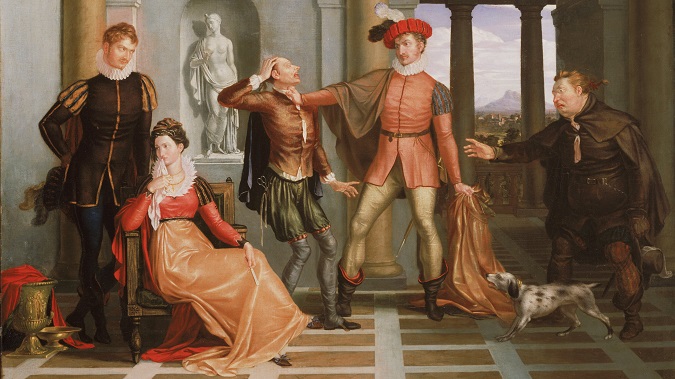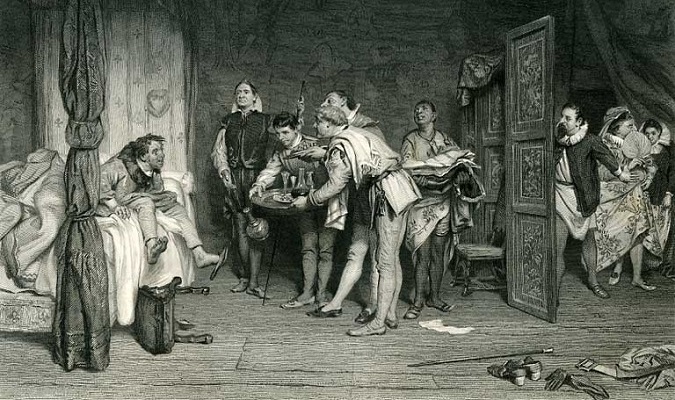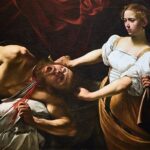
One of the main theatrical devices in almost any play is the clothing of the characters. The different types of clothes and adornments of the characters enable the writer to portray important aspects of the play without words – social class, economic status, official position and even gender during the past times in which only male actors were allowed to perform in the theatres.
In William Shakespeare’s play, The Taming of the Shrew, clothing is not only a central motif used to help build up various characterizations in the play, but it is also the primary device to convey the themes of disguise, social class and marriage. This essay will discuss The Taming of the Shrew’s clothing motif, its relations to the play’s central themes, and how it operates as another measure of characterization.
The Lord’s Characterization through Clothing
Almost immediately at the Induction’s beginning, the different functions of the clothing motif are divulged to the readers/viewers of the play. When the Lord enters the tavern and sees the drunkard Sly wholly passed out, he reflects if Sly will “forget himself” when he wakes up in a foreign bed “Wrapp’d in sweet clothes, rings put upon his fingers” (Induction.1.38).
This scene highlights two critical distinguishments about the Lord. First, it characterizes the Lord’s dubious morality because he unhesitatingly decides to deceive other people by changing their attires in vulnerable moments. Second, it presents the themes of disguise and social class through different clothing. However, while throughout the rest of the play, the other characters disguise their own selves to lower their social class for pragmatic reasons, here the Lord actually veils another person to raise his social status for nothing but a practical joke.
In addition, the Lord orders that his servant Bartholomew will be “dress’d in all suits like a lady” (Induction.1.106) in order to trick Sly into believing that he has a wife from a high social class. This is the only gender transformation by disguise in the play, which furthermore characterizes the superiority of the Lord in the play, perhaps only second to Shakespeare himself.

“Changing” Social Class by Changing Clothes
The Taming of the Shrew is, in fact, a play within a play, in which a couple of characters disguise themselves as lower-class schoolmasters to obtain a high-class marriage.
After Lucentio sees Bianca for the first time and utterly falls for her, he devises a plan to wed her – he exchanges clothes with his servant Tranio and disguises as a schoolmaster to get near Bianca while Tranio will role-play him (1.1.198-209). This ruse characterizes Lucentio as an assertive and daring individual on the one hand, but on the other, also as unstable and impulsive because just a few moments earlier, he proclaims his utter dedication solely to his academic studies and nothing else.
Another suitor of Bianca, Hortensio, also decides to disguise himself as a schoolmaster to pursue her; however, that characterizes him quite differently than Lucentio. Hortensio asks Petruchio if he could “offer (him) disguis’d in sober robes” (1.2.132), so he will woo Bianca under the pretense of a music instructor. Unlike young Lucentio, Hortensio is an older man, and therefore, this ploy portrays him quite pitifully rather than in a playfully youthful manner as it might in Lucentio’s case. When Lucentio disguises as a schoolmaster, this act could be ascribed to his mischievous juvenility, but for Hortensio, it reeks of old-age desperation. Even though both Lucentio and Hortensio play the same game of disguise by changing their clothes, they are not characterized similarly due to their age differences.
These acts of disguise also stress the themes of social class and proper marriage, which the characters are really determined to win.
Taming via Clothing
In one of the most dramatic events of the play, the clothing motif takes the most prominent role in the scene. When everybody awaits the late Petruchio to show up at his own wedding, the servant Biondello announces his belated arrival by meticulously describing his shaggy appearance (3.2.43-63). Baptista is shocked to recognize that Biondello’s description is accurate and demands that Petruchio change into more suitable clothes for the wedding with his daughter; thereupon, Petruchio refuses and retorts that “To me she’s married, not unto my clothes” (3.2.117).
Petruchio’s ragged garments and rude responses elucidate how far he intends to go with his “taming” and indicate that he holds very little regard for social conventions when they conflict with his goals, even in an important social event such as his own marriage ceremony. The choice of disheveled apparel and late arrival, which completely humiliates Katharina, symbolizes Petruchio’s view of their marriage – the shrew wife must be vehemently tamed, even at the expense of socially accepted norms. Petruchio is not entirely crazy to don such unseemly clothes to the wedding ceremony, and even Tranio validates, “He hath some meaning in his mad attire” (3.2.124).
The fact that Baptista eventually accedes to giving away his daughter to such an erratic person, who intentionally dresses for his own wedding sloppily, emphasizes Baptista’s eagerness to marry Katharina already.
The clothing motif has another notable part throughout another scene in which Petruchio abuses Katharina. A while after the newlywed arrives at Petruchio’s house, Petruchio orders a new gown from a tailor for Katharina. When the tailor displays the gown to the couple, Petruchio pretends it is not what he requested, while Katharina exclaims in surprise that she “never saw a better fashion’d gown” (4.3.101). This exhibits how Petruchio slyly acts on two levels: first, he allegedly does something nice for Katharina; second, he does this presumably generous gesture only as a means to ultimately torment her. To add more to Katharina’s maltreatment, thereafter, Petruchio and his servant Grumio begin a long back and forth bantering with the tailor, in which they feign an inquiry of why the gown was marred, whereas they only actually wish to exhaust Katharina. Eventually, Petruchio sends the tailor away with the gown and declares that he and Katharina will leave for Baptista’s house with their “garments poor” (4.3.171).
This scene affirms again how resolute Petruchio is to tame Katharina and that he does not really care if he humiliates other people along the way, such as the tailor, as long as it serves his taming interests. In fact, by visiting respectable members of society in poor clothes later, Petruchio shows that he is even willing to risk his own social stature and humiliate himself as well for the purposes of taming Katharina and his twisted version of the ideal marriage.
In the final scene of the play, there is a utilization of the clothing motif to demonstrate that the full cycle of Katharina’s taming is completed. Petruchio wins the bet amongst the three competing husbands for having the most obedient wife; on top of that, Katharina afterward also brings with her the other two “shrewish” wives, Bianca and the widow. However, Petruchio is not satisfied yet, so he orders Katharina to throw away her hat in front of everybody for no real logical reason: “Katharina, that cap of yours becomes you not: / Off with that bauble, throw it underfoot” (5.2.121-122). Katharina dutifully complies and thus confirms that she is indeed now tamed, to the amazement of the widow and Bianca.
Alternatively, this could characterize Katharina’s comprehension of her husband in spite of all and that she finally agrees to fully partake in his chauvinistic displays for the sake of herself and her marriage. Lastly, this event might reflect the social setting of those times when men desired that their wives would merely be docile and meek, as echoed by Lucentio’s response to Bianca: “I would your duty were as foolish too” (5.2.126).
Conclusion
In The Taming of the Shrew, Shakespeare uses the clothing motif far beyond its mere apparent function of just apparel. As demonstrated, under the surface, clothing is an important motif of the play that conveys, often as the primary device, the play’s main themes of disguise, social class and marriage. In addition, this motif assists the readers/viewers to better understand on a deeper level the unique characterization of characters such as Lucentio, Hortensio, Petruchio and Katharina in a very visual manner.
Shakespeare’s concoction of material elements such as clothes combined with intangible features like the thickening plot and the witty dialogues results in a fantastic spectacle of comedy, which raises the meaningful thematic issues of social class and marriage in a highly entertaining way.



